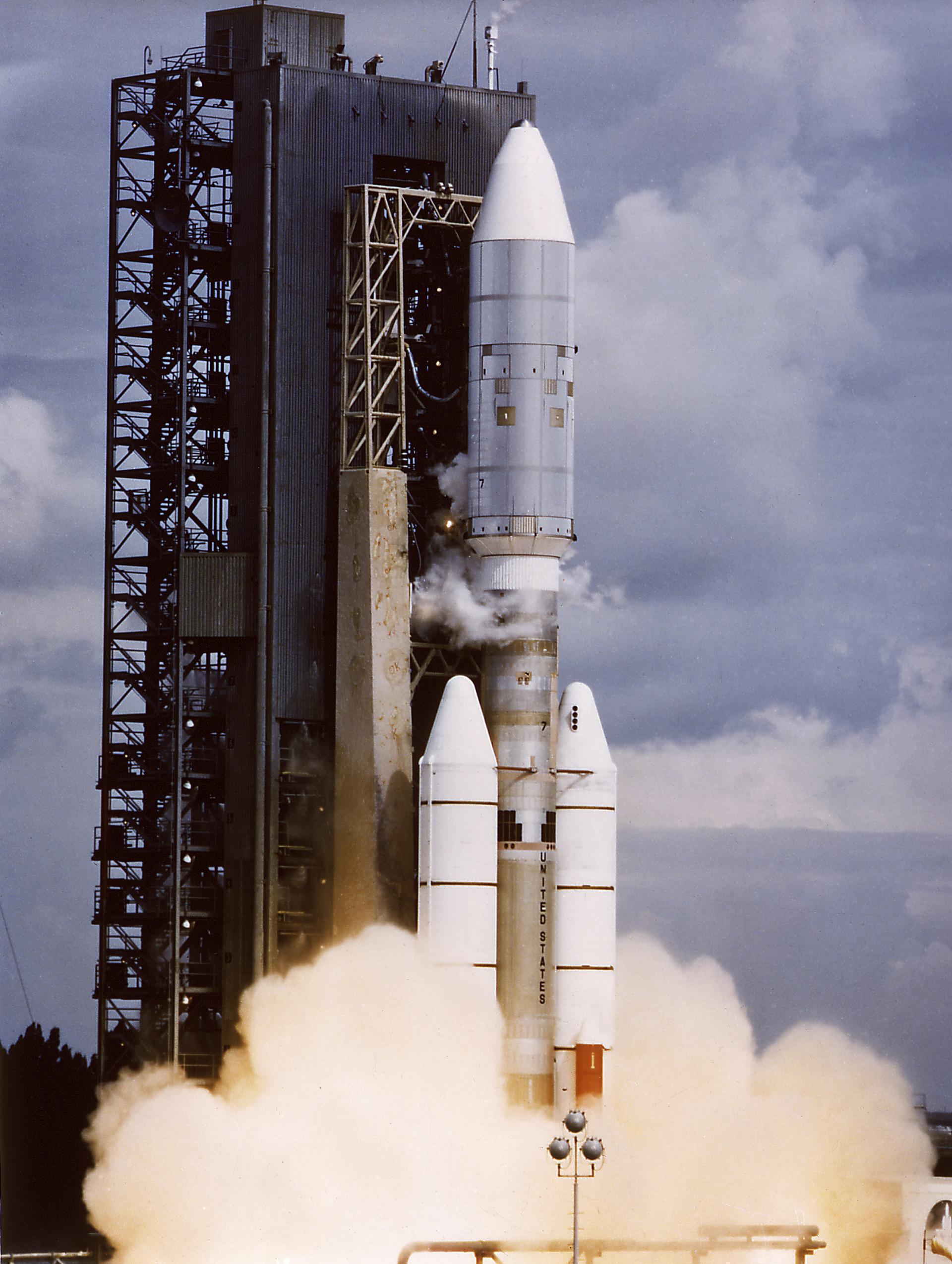
Titan III
In-activeLockheed Martin (LMT)
Feb. 11, 1974
Description
Specifications
-
Minimum Stage
3 -
Max Stage
4 -
Length
48.8 m -
Diameter
3.05 m -
Fairing Diameter
― -
Launch Mass
632.0 T -
Thrust
12991.0 kN
Family
-
Name
Titan III -
Family
― -
Variant
E -
Alias
― -
Full Name
Titan IIIE
Payload Capacity
-
Launch Cost
― -
Low Earth Orbit
15400.0 kg -
Geostationary Transfer
Orbit
― -
Direct Geostationary
― -
Sun-Synchronous Capacity
―
Lockheed Martin
Commercial
None
LMT 1953Lockheed Martin's Space Division started in the production of missiles and later ICBM's in the 1950s. Their TITAN missile system was used for 12 Gemini spacecraft and the Voyager probes. They have worked largely in collaboration with NASA on many of their probes, landers, and spacecraft, and hope to play a key role in NASA's return to the moon in 2024.
Titan IIIE | Voyager 1
Lockheed Martin | United States of AmericaCape Canaveral SFS, FL, USA
Sept. 5, 1977, 12:56 p.m.
Titan IIIE | Voyager 2
Lockheed Martin | United States of AmericaCape Canaveral SFS, FL, USA
Aug. 20, 1977, 2:29 p.m.
Status: Launch Successful
Mission:
Voyager 2 is a space probe launched by NASA on August 20, 1977, to study the outer planets. Part of the Voyager program, it was launched 16 days before its twin, Voyager 1, on a trajectory that took longer to reach Jupiter and Saturn but enabled further encounters with Uranus and Neptune. It is the only spacecraft to have visited either of the ice giants.
Solar Escape TrajectoryTitan IIIE | Helios-B
Lockheed Martin | United States of AmericaCape Canaveral SFS, FL, USA
Jan. 15, 1976, 5:34 a.m.
Status: Launch Successful
Mission:
Helios-A and Helios-B (also known as Helios 1 and Helios 2), are a pair of probes launched into heliocentric orbit for the purpose of studying solar processes. A joint venture of West Germany's space agency DFVLR (70% share) and NASA (30%), the probes were launched from Cape Canaveral, Florida, on December 10, 1974, and January 15, 1976, respectively. Built by Messerschmitt-Bölkow-Blohm as the main contractor, they were the first spaceprobes built outside the United States or Soviet Union.
Heliocentric N/ATitan IIIE | Viking 2
Lockheed Martin | United States of AmericaCape Canaveral SFS, FL, USA
Sept. 9, 1975, 6:39 p.m.
Status: Launch Successful
Mission:
The Viking 2 mission was part of the American Viking program to Mars, and consisted of an orbiter and a lander essentially identical to that of the Viking 1 mission. The Viking 2 lander operated on the surface for 1316 days, or 1281 sols, and was turned off on April 11, 1980 when its batteries failed. The orbiter worked until July 25, 1978, returning almost 16,000 images in 706 orbits around Mars.
Heliocentric N/ATitan IIIE | Viking 1
Lockheed Martin | United States of AmericaCape Canaveral SFS, FL, USA
Aug. 20, 1975, 9:22 p.m.
Status: Launch Successful
Mission:
Viking 1 was the first of two spacecraft (along with Viking 2) sent to Mars as part of NASA's Viking program. On July 20, 1976, it became the first spacecraft to land successfully on Mars and perform its mission. Viking 1 held the record for the longest Mars surface mission of 2307 days or 2245 sols until that record was broken by Opportunity on May 19, 2010.
Heliocentric N/ATitan IIIE | Helios-A
Lockheed Martin | United States of AmericaCape Canaveral SFS, FL, USA
Dec. 10, 1974, 7:11 a.m.
Status: Launch Successful
Mission:
Helios-A and Helios-B (also known as Helios 1 and Helios 2), are a pair of probes launched into heliocentric orbit for the purpose of studying solar processes. A joint venture of West Germany's space agency DFVLR (70% share) and NASA (30%), the probes were launched from Cape Canaveral, Florida, on December 10, 1974, and January 15, 1976, respectively. Built by Messerschmitt-Bölkow-Blohm as the main contractor, they were the first spaceprobes built outside the United States or Soviet Union.
Heliocentric N/ATitan IIIE | Sphinx (Titan IIIE Maiden Flight)
Lockheed Martin | United States of AmericaCape Canaveral SFS, FL, USA
Feb. 11, 1974, 1:48 p.m.
Electron
Raise and Shine (RAISE-4)
Rocket Lab Launch Complex 1B - Rocket Lab Launch Complex 1, Mahia Peninsula, New ZealandRAISE-4 (RApid Innovative payload demonstration Satellite-4) is a Japan Aerospace Exploration Agency (JAXA) satellite for on-orbit demonstrations of …
Kuaizhou 11
DEAR-5
Launch Area 95A - Jiuquan Satellite Launch Center, People's Republic of ChinaDEAR-5 is a commercial in-orbit payload and micro-gravity experiments hosting spacecraft developed by Chinese commercial company AZSPACE for various …
Long March 12
SatNet LEO Group 16
Commercial LC-2 - Wenchang Space Launch Site, People's Republic of ChinaA batch of Low Earth Orbit communication satellites for the Chinese state owned SatNet constellation operated by the China Satellite Network Group. …
Falcon 9
Starlink Group 6-90
Space Launch Complex 40 - Cape Canaveral SFS, FL, USAA batch of 29 satellites for the Starlink mega-constellation - SpaceX's project for space-based Internet communication system.
Falcon 9
Starlink Group 15-11
Space Launch Complex 4E - Vandenberg SFB, CA, USAA batch of 27 satellites for the Starlink mega-constellation - SpaceX's project for space-based Internet communication system.

